|
|
|
In the “olden days” (okay, before 1960s), people might buy things from a local merchant and put it on their account. That meant they would come up with the money later and pay the retailer or risk having a bill collector come after them.
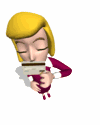 Then in the 1960s, credit cards were introduced. Now you can use a card to make your purchases, the merchant gets paid, and you owe the credit union or bank that issued you the credit card. Then in the 1960s, credit cards were introduced. Now you can use a card to make your purchases, the merchant gets paid, and you owe the credit union or bank that issued you the credit card.
Here’s an example: You apply for a credit card from a credit union or bank, which issues a card based on information in your credit report. You get a line of credit (often called a credit limit) usually somewhere between $500 to $10,000, although certain cards have limits over $100,000.
You will be allowed to make purchases that add up to the maximum amount of your credit limit as long as you pay the monthly minimum payment every time you get your bill. The minimum amount varies based on the card issuer.
The financial institution that issues you a credit card charges you interest for your right to borrow money so that you can make your purchases on credit.
 When credit cards were first introduced, everyone paid off their card balance each month. Since then, many people carry a balance from one month to the next and end up owing a lot of money from their spending and the interest charged. This is known as revolving debt. When credit cards were first introduced, everyone paid off their card balance each month. Since then, many people carry a balance from one month to the next and end up owing a lot of money from their spending and the interest charged. This is known as revolving debt.
|
If you pay off everything you owe on your credit card, you can charge up to your credit limit all over again.
If you go over your spending limit but you have been making regular payments, the credit union or bank may raise the limit on the card.
But let’s say you can only pay the minimum amount. 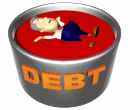 You’ll be charged interest on the balance, and your next bill will include last month’s balance plus interest and this month’s purchases. Unless you’re careful, you’ll be swimming in credit card debt! You’ll be charged interest on the balance, and your next bill will include last month’s balance plus interest and this month’s purchases. Unless you’re careful, you’ll be swimming in credit card debt!
How to avoid being in over your head?
-
Understand the terms of your credit agreement. Know how much you have to pay each month and what the fees are.
-
Save all your receipts so you’ll have a record of how much money you have charged each month. This will also help if there’s a mistake with your bill.
-
Don’t use your credit card every time you buy something. Pay with cash whenever you can.
-
Plan ahead and try to spread out buying expensive items over time so you won’t be stuck with a large credit card bill all at once.
-
Choose one or two credit cards to use so it’s easier to keep track of your money and you’ll limit the amount of fees and interest.
|
|
|
|
|
Used responsibly, credit cards can be a tremendous convenience. Credit cards eliminate the need to carry around a lot of cash with you. They let you purchase things now, rather than wait until you have saved up enough to buy things with cash.
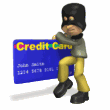 And they’re safer than carrying cash. If cash is lost, you’re out the money. But if your credit card is lost or stolen and you notify the issuer right away, you won’t be responsible for the purchases the thief makes. And they’re safer than carrying cash. If cash is lost, you’re out the money. But if your credit card is lost or stolen and you notify the issuer right away, you won’t be responsible for the purchases the thief makes.
You may find you need a credit card to make hotel or airline reservations, rent a car, or make online purchases. They’re also a great way to build a good credit history and for use in emergency situations.
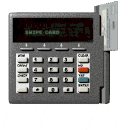 So how do credit cards work? Let’s say you buy $20 worth of gasoline with a Visa card. The cashier has you pass your card through a machine. Visa takes $20 out of the credit union or bank that issued your card and puts it into the gas station’s account at its credit union or bank. So how do credit cards work? Let’s say you buy $20 worth of gasoline with a Visa card. The cashier has you pass your card through a machine. Visa takes $20 out of the credit union or bank that issued your card and puts it into the gas station’s account at its credit union or bank.
The gas station has to pay Visa a fee, usually 3% to 4% of the $20 purchase price. The credit union or bank that issued the Visa card puts the $20 purchase on your record, and includes it on your monthly bill.
 Visa, MasterCard, Optima and Discover cards are accepted at most stores, restaurants, hotels, car rental companies and more because these merchants know that people usually spend more money with credit cards than with cash. Visa, MasterCard, Optima and Discover cards are accepted at most stores, restaurants, hotels, car rental companies and more because these merchants know that people usually spend more money with credit cards than with cash.
|
Technically, you don’t really have a credit card with Visa, MasterCard, Discover or Optima. You have a credit card with one of the 23,000+ credit unions and banks that issue credit cards. 
Because there are thousands of financial institutions issuing cards, there are practically as many credit cards with different rules, interest rates and fees. You can save money by comparing features and fine print.
Some credit card issuers give you special bonuses for using their card, such as airline frequent flyer miles or donations to charities. Some even offer protection on things you purchase so if you lose or break the item within a certain time period, they'll replace it for free.
Most credit cards also allow “cash advances,” which basically means you can get cash by charging money.  Card issuers often give you checks you can write out to yourself to get cash or to pay other bills. Usually there is a cash advance fees and a higher interest rate when you get money this way. Card issuers often give you checks you can write out to yourself to get cash or to pay other bills. Usually there is a cash advance fees and a higher interest rate when you get money this way.
Credit cards such as Diners Club and American Express work a bit differently. They were originally designed for travelers who wanted to charge restaurant and hotel expenses on a trip, and then pay it all off when they got home.
With these cards, you must pay off everything you owe at the end of every month or face penalty charges. Many businesses use them as a way to keep track of their employees’ travel and entertainment expenses for tax purposes.
|
|
|
|
|
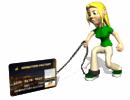 While card issuers are usually more than happy to extend credit to just about anyone, some people with bad credit ratings can’t get anything but a secured credit card. These work like phone cards. You go to a credit union or bank and put down an amount of money, for example, $2,000. Every time you charge something, that amount is subtracted from the $2,000. When you’ve spent $2,000, the card won’t work until you put more money into the account. While card issuers are usually more than happy to extend credit to just about anyone, some people with bad credit ratings can’t get anything but a secured credit card. These work like phone cards. You go to a credit union or bank and put down an amount of money, for example, $2,000. Every time you charge something, that amount is subtracted from the $2,000. When you’ve spent $2,000, the card won’t work until you put more money into the account.
By the way, there are companies that offer to get you a credit card if you don't qualify for one. They will charge you money and set up a secured card. This is something you can do yourself for free.
Debit cards are not credit cards, although they look very much like them. When you use a debit card, your credit union or bank immediately takes the money out of your checking or savings account. If there’s not enough money in the accounts, your debit card may be refused or your account may be hit with fees.
|
Some debit cards can be connected to credit card accounts. That way, if you don’t have enough money in your account to cover your purchase, it becomes a credit card purchase.
 The future of credit cards is the so-called “Smart Card” that has a microprocessor in it. These cards, already popular in Europe, allow the user to access credit cards accounts, checking and savings accounts, office accounts, identifying information and all kinds of data. The future of credit cards is the so-called “Smart Card” that has a microprocessor in it. These cards, already popular in Europe, allow the user to access credit cards accounts, checking and savings accounts, office accounts, identifying information and all kinds of data.
So give yourself credit -- but use it responsibly!
For more information, see the Federal Trade Commission's website on Credit Cards & Loans.
See what you learned.
Check out: "Credit Card Shuffle: How to Get the Best Deal" and "Your Credit Report Card"
|
|
|